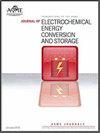基于融合Rauch-Tong-Streebel平滑结构的迭代无迹卡尔曼滤波算法的锂离子电池SOC和SOH联合估计
IF 1.9
4区 工程技术
Q3 ELECTROCHEMISTRY
Journal of Electrochemical Energy Conversion and Storage
Pub Date : 2022-12-23
DOI:10.1115/1.4056557
引用次数: 0
摘要
传统的粒子滤波对电动汽车锂电池的充电状态和锂离子电池健康状况有很大的估计误差。针对上述问题,建立了锂电池二阶RC等效电路模型,并利用多创新最小二乘算法(MILS)对模型参数进行了识别。最后,提出了一种融合Rauch-Tong-Striebel平滑结构的迭代无迹卡尔曼滤波算法(RTS-IUPF),用于锂离子电池SOC和SOH的联合估计。该算法基于电池参数的识别,控制器读取传感器数据并预测状态结果。RTS平滑结构可以进行后验估计,并生成显著概率密度函数来选择最优粒子,无迹卡尔曼算法对粒子进行正则化。该算法减少了传统非选择卡尔曼滤波器中过程噪声协方差矩阵和测量噪声协方差矩阵对滤波器精度和响应时间的影响。文中提出的算法改善了粒子的退化,提高了估计精度。最后,RTS-IUPF算法分别在脉冲电流放电条件和动态电流条件下进行了仿真分析。脉冲电流实验结果表明,UKF和PF(粒子数N为300)的平均绝对值误差分别为1.26%和1.24%,而RTS-IUPF的误差为0.748%。与UKF和PF相比,RTS-IUPF的均方根误差降低了66.5%和77.8%。此外,使用该算法进行联合估计的误差小于单次估计的误差。与RTS-IUPF相比,RTS-IUPF-Joint的RMSE降低了27.4%。验证了该算法用于锂电池SOC和SOH联合估计的可行性和有效性。本文章由计算机程序翻译,如有差异,请以英文原文为准。
SOC and SOH Joint Estimation of Lithium-Ion Battery Based on Iterative Unscented Kalman Particle Filtering Algorithm with Fused Rauch-Tung-Striebel Smoothing Structure
Traditional particle filtering has a large estimation error in the state of charge and Lithium-ion battery health of electric Vehicle lithium batteries. For the above problems, the lithium battery second-order RC equivalent circuit model is established, and then the model parameters are identified using the multi-innovation least square algorithm (MILS). Finally, Iterative unscented Kalman particle filtering algorithm with fused Rauch-Tung-Striebel Smoothing Structure (RTS-IUPF) applied to Li-ion battery SOC and SOH joint estimation is proposed. The algorithm is based on the identification of battery parameters, the controller reads the sensor data and predicts the state results. RTS smoothing structure can do posterior estimation, and a significant probability density function is generated to select the optimal particle, and unscented Kalman algorithm regularized particles. The algorithm reduces the effect of the process noise covariance matrix and the measured noise covariance matrix on the filter accuracy and response time in traditional unselected Kalman filters. The algorithm proposed in the paper improves particle degradation and increases the estimation accuracy. Finally, the RTS-IUPF algorithm performs simulation analysis in Pulse current discharge condition and dynamic current condition (NEDC) respectively. The pulse current experimental results show that the mean absolute value error of UKF and PF (Number of particles N is 300) are 1.26% and 1.24%, respectively, while the error of the RTS-IUPF is 0.748%. The RMSE of the RTS-IUPF is reduced by 66.5% and 77.8% compared with UKF and PF. Furthermore, The error of joint estimation using this algorithm is smaller than that of single estimation. The RMSE of the RTS-IUPF Joint is reduced by 27.4% compared with RTS-IUPF. The feasibility and effectiveness of the algorithm for the joint estimation of SOC and SOH of lithium batteries were verified.
求助全文
通过发布文献求助,成功后即可免费获取论文全文。
去求助
来源期刊

Journal of Electrochemical Energy Conversion and Storage
Engineering-Mechanics of Materials
CiteScore
4.90
自引率
4.00%
发文量
69
期刊介绍:
The Journal of Electrochemical Energy Conversion and Storage focuses on processes, components, devices and systems that store and convert electrical and chemical energy. This journal publishes peer-reviewed archival scholarly articles, research papers, technical briefs, review articles, perspective articles, and special volumes. Specific areas of interest include electrochemical engineering, electrocatalysis, novel materials, analysis and design of components, devices, and systems, balance of plant, novel numerical and analytical simulations, advanced materials characterization, innovative material synthesis and manufacturing methods, thermal management, reliability, durability, and damage tolerance.
 求助内容:
求助内容: 应助结果提醒方式:
应助结果提醒方式:


